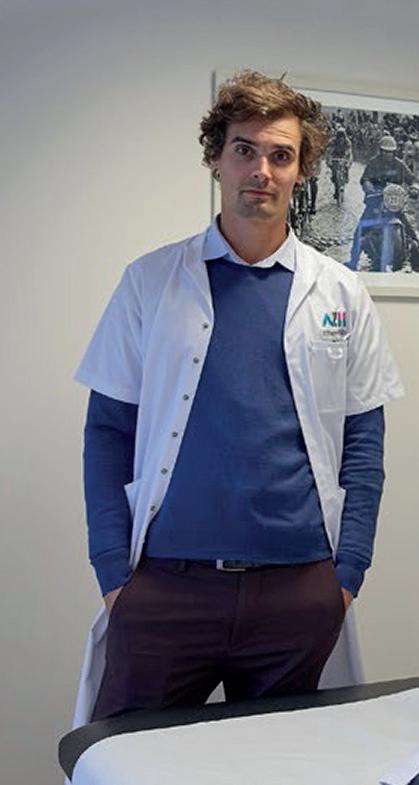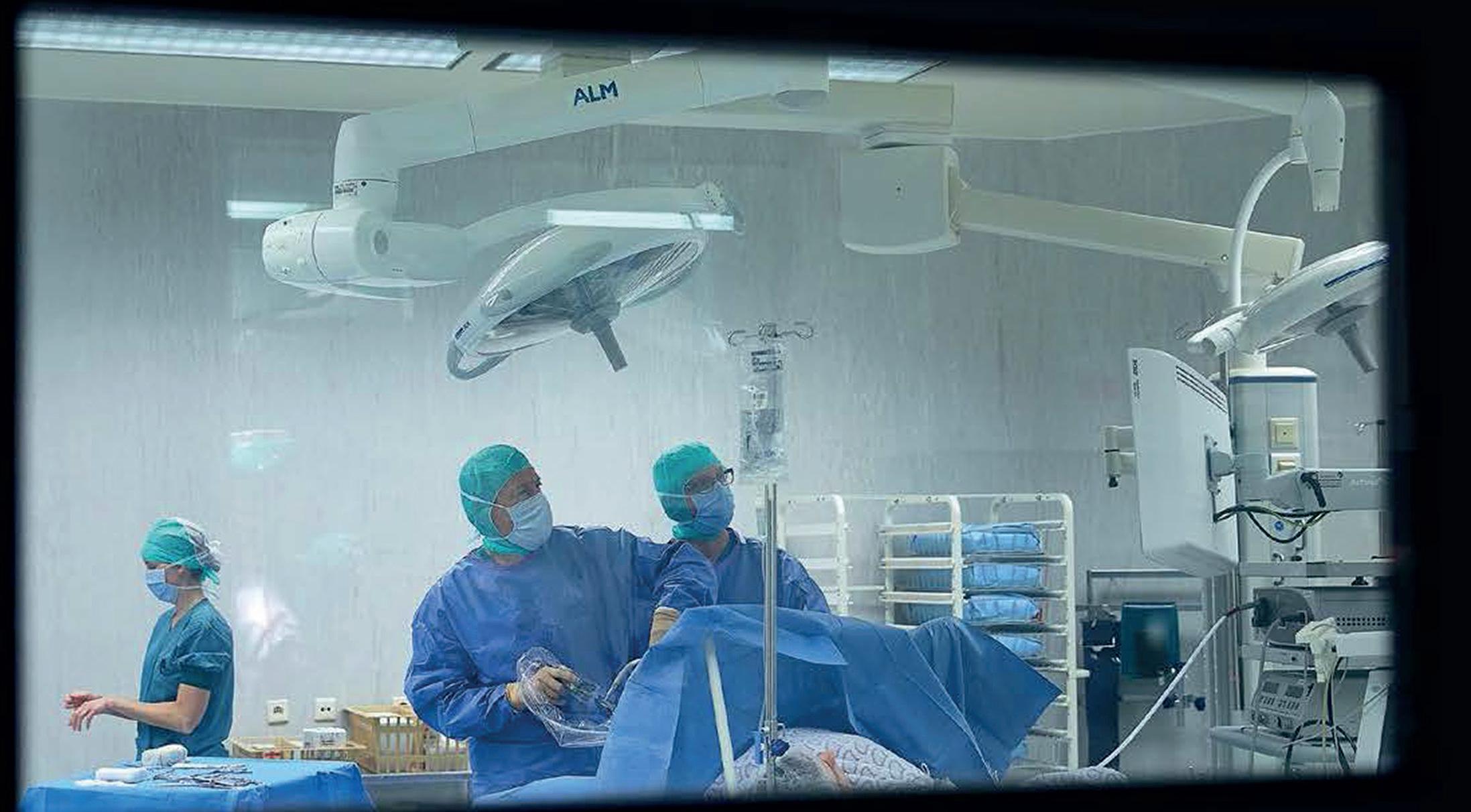
7 minute read
ATHLETES REQUIRE A LOT OF ATTENTION, BOTH BEFORE AND AFTER THE TREATMENT.
– Dr. Tom Claes –
Orthopedic surgeon - AZ Herentals
The name Claes will definitely sound like music to the ears of many cyclists, although when they meet him it’s often because they are in some kind of ‘miserable’ situation. It is almost impossible to find a Belgian rider who has never been to the orthopedic ward of the hospital in Herentals. With Toon Claes as the absolute pillar, and his sons Tom and Steven and 6 other colleagues as his lieutenants, Herentals is 'the place to be’ for cyclists with collarbone fractures, knee injuries and other locomotor problems. We had an interesting conversation with Tom, who told us that Greg Van Avermaet once told him: “Your father is not here, but you are a Claes, so you can do it!” No pressure, you know ...
Doctor Claes, talking about cyclists, what are the most common injuries?
Cyclists suffer most of their acute injuries on the collarbone. When they fall, riders often fall on their shoulder. However, we also see quite a lot of chronic injuries. Riders do a huge amount of rotations, which may cause several types of friction problems at the knee. This can cause serious problems for professional cyclists.
What are the biggest challenges for you as a surgeon?
If a rider is involved in a fall and suffers an injury, it is important in the first place that he can reach us. We have to be available at all times, also during weekends. Decisions have to be made quickly. Waiting one day longer before operating can be crucial for important races that may have been scheduled. That’s where we try to make a difference. Besides, athletes require a lot of attention, both before and after the treatment. They call us and ask for advice: what can I do, is this or that sensation normal, etc. These seem to be trivial matters, but for the riders it is very important. And we try to give cyclists the support they need.
At some point you were watching the Tour of Flanders at home when Greg Van Avermaet fell and broke his collarbone. And your first thought was: “That’s for me!”
Indeed, I immediately transformed from a spectator into a surgeon. I knew then that there was a big chance that he would come to Herentals and I did indeed operate on Greg that same evening. The next day the rider feels better already, and that is very important mentally. They have much less pain because the fracture is stabilised with a plate and screws. So the pain is less and they can start thinking about building up again and forget their misery. After a day or two they can start riding on the rolls, calmly, making sure their condition does not suffer too much. This is not just the case for cyclists, though, also for self-employed persons, for example. A self-employed baker who breaks his collarbone cannot afford to be out for long. In that case we also have to act quickly and adequately.
Your father once said: “The result depends on the extent to which a patient gives his body the chance to recover.” What does a standard recovery look like for a cyclist/athlete ?
People who are not in top sports sometimes complain that their recovery takes longer than that of an athlete. And, of course, you can’t compare apples and oranges. It often concerns different types of injury, and we will always ‘push’ cyclists more to the limits. It’s often walking on a thin line, and we try to avoid crossing a certain border. It is important to know how the rider feels. We recommend them to listen to their body at all times and build up from there. In case of a collarbone fracture we make it very rigid by applying a plate and screws. And then it’s up to mother nature to heal the fracture underneath. Besides, a force is exerted on that plate and if the load is too heavy it can also start to fail, and even break. It’s not so bad for cyclists, but it’s different for motorcyclists. If they go through a heavy fall again four weeks after the plate was put in place, the plate may bend or even break. We always explain the risks, but top athletes do everything for their sport, they search and sometimes cross the boundaries.

Mental strength is indisputably very important for a good recovery What is your role in this area?
We immediately try to anticipate how the rider is coping, what his mental condition is. If the rider indicates that the races which are coming up are less important for him, there’s no need to push him. He has made a mental click at that point and will take things slowly. But there are others who want to be back on their bike as soon as possible and who want to be racing to their maximum capacity in four weeks time. We support the rider in what he wants, as long as it can be medically supported.
They say it’s important to apply the right treatment at the right time. On the basis of which factors is this decided?
My opinion is that, for most fractures, action has to be taken asap. If you wait a couple of days, scar tissue will already start to form. The motto is: the fresher, the better. There are of course some grey areas, doubtful cases. Not so long ago we had a young cyclist come to see us from West-Vlaanderen, he came to see us because we have a certain name in the cycling world. The patient had expected that we would operate on him immediately but the fracture was moved only slightly and he was still very young. The patient had come to see us to get surgery and to get back on his bike as soon as possible. At such a moment we are put under some pressure, but in medical terms it was not a good idea. We explained this to the patient, that it heals just as well and just as fast without an operation, and of course they accept that.
Do you give advice to athletes about how they can avoid certain injuries?
We do so especially when it concerns athletes who suffer from knee injuries. We are now a team of nine orthopaedists, and I am almost exclusively working on shoulders. For chronic injuries - mainly knee and hip injuries - things are a bit different. You can certainly take preventive action, for example by correctly positioning the cleats on the shoes, correctly positioning the pedals or the saddle height.
Abrasions on top of another injury probably require a different approach from you ...
When a cyclist falls on his shoulder, this may sometimes cause a large scrape. If the skin is grazed in the exact spot where we have to operate, we prefer not to do it. We don’t like cutting through damaged skin. Although this doesn’t happen very often, because the impact is actually on the shoulder and our incision is usually more at the collarbone. During the operation the injury is always carefully covered to make sure that we can do a clean job.
Let us have a look in our crystal ball ... Are there visions or new practices in this domain which may lead to new views on the matter or new approaches in the future?
What we are already doing is 3D printing. Today, we are capable of determining defects based on scans, which allow us to print tailored implants in 3D. We don’t do this for athletes, but for seriously worn shoulders which need a shoulder prosthesis. Besides, there are some ongoing developments in the area of robotic surgery, mainly in the field of knee prostheses. By means of robots the components are very accurately positioned. Human assistance is obviously still required, but the precision of a robotic arm is more accurate than a human arm. In urology procedures this technique has long proven its worth. Finally, can I make some publicity? On 20 October we are organising our sports conference, and this year cycling - and more specifically cycling injuries - are the central topic. The target group of this conference are sports doctors, physiotherapists, soigneurs ... Besides us, there will be many interesting speakers from the cycling pack, as well as some riders. The topics that will be discussed include: collarbone fractures, chronic knee injuries, how does everything work from a biomechanical perspective, how can injuries be avoided. Everyone who is interested can join us. Welcome!



